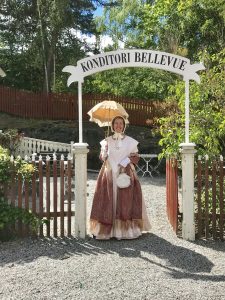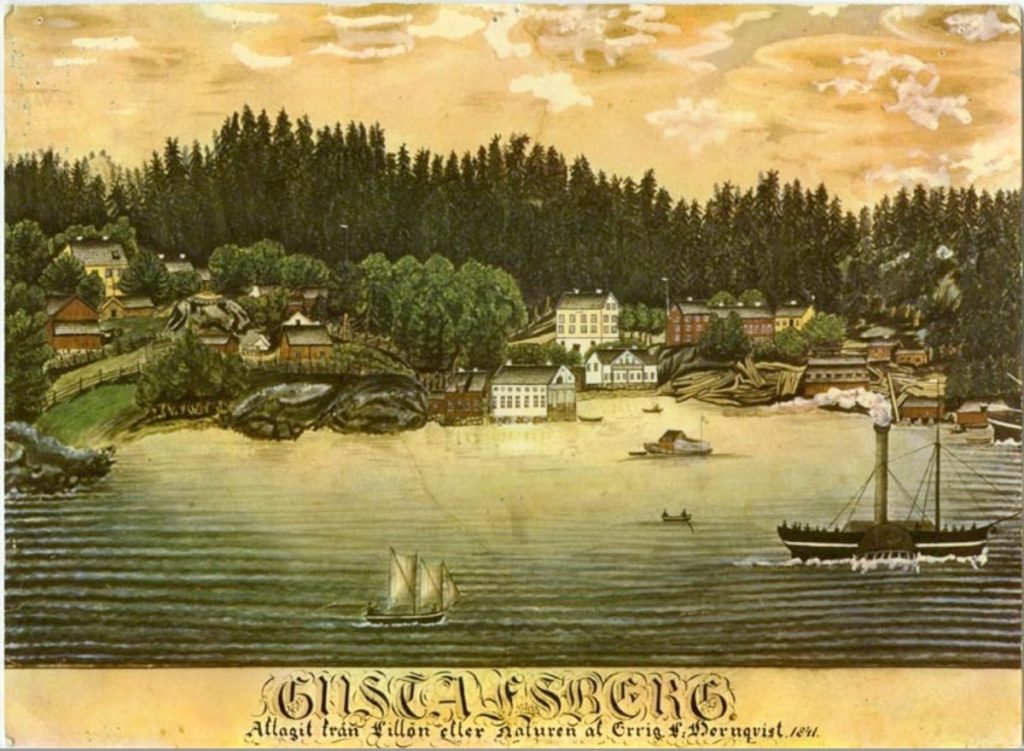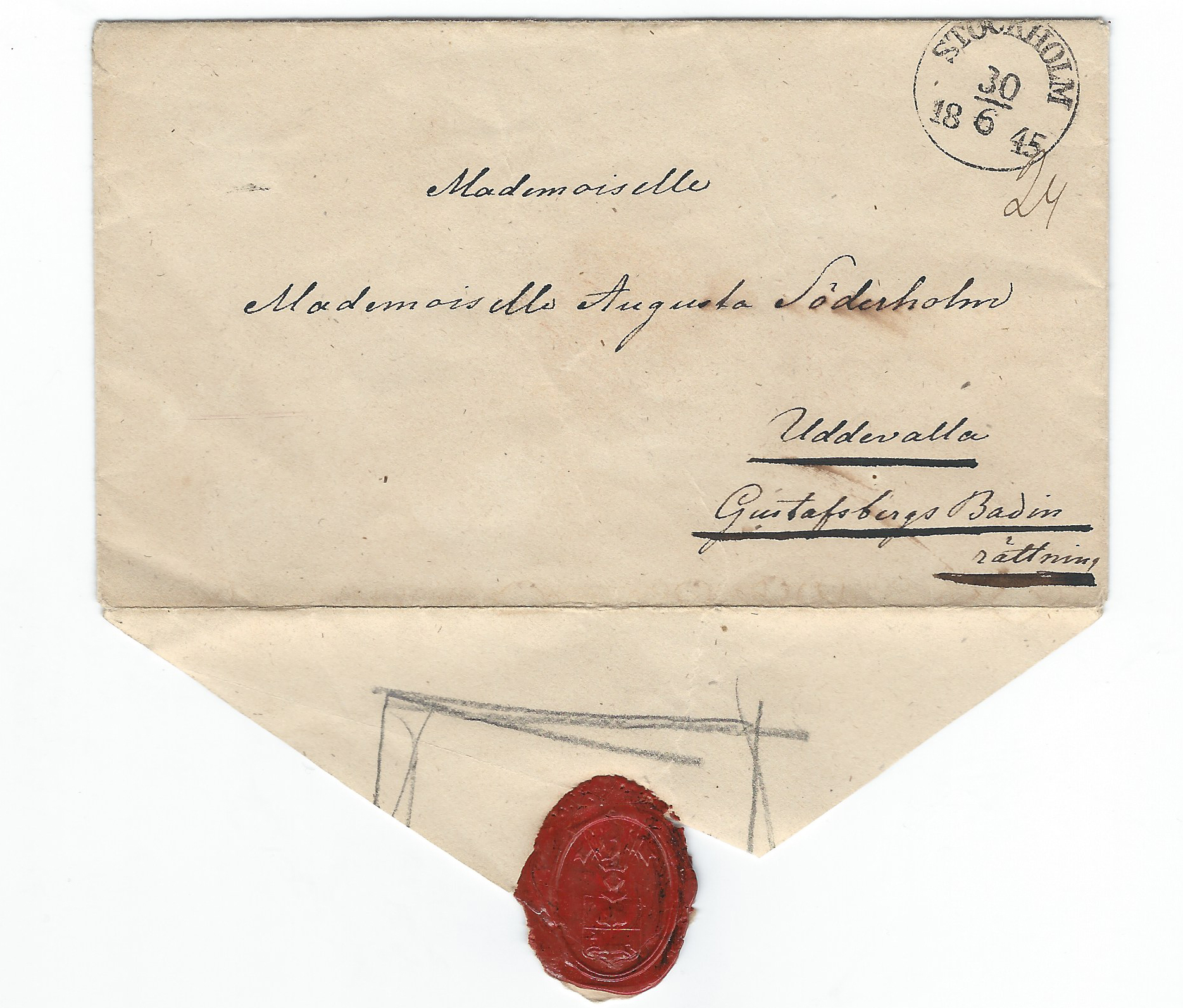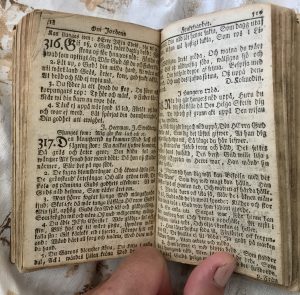 Har du vägarna förbi, kom och träffa oss under de fantastiska 1800talsdagarna!
Har du vägarna förbi, kom och träffa oss under de fantastiska 1800talsdagarna!
Vi berättar om Augustas resa och om den första generationens turister på 1800-talet.
Klicka här för information om 1800talsdagarna
 Har du vägarna förbi, kom och träffa oss under de fantastiska 1800talsdagarna!
Har du vägarna förbi, kom och träffa oss under de fantastiska 1800talsdagarna!
Vi berättar om Augustas resa och om den första generationens turister på 1800-talet.
Klicka här för information om 1800talsdagarna
 Midsommar 1845 tillbringade Augusta och hennes mamma vid Gustafsbergs badinrättning i Uddevalla. Jag skrev om mamma Annas förberedelser i förra veckans blogg. Gustafsberg benämns som Sveriges äldsta badort. Som brunnsort har den en ännu äldre historia.
Midsommar 1845 tillbringade Augusta och hennes mamma vid Gustafsbergs badinrättning i Uddevalla. Jag skrev om mamma Annas förberedelser i förra veckans blogg. Gustafsberg benämns som Sveriges äldsta badort. Som brunnsort har den en ännu äldre historia.
På 1780-talet hade man som en del av behandlingen börjat komplettera brunnsdrickandet med salta bad och Gustafsberg kan därmed betraktas som Sveriges första badort. Kurorten blev populär 1804, när Gustav IV Adolf sänt sin sjuklige 4-årige kronprins till Gustafsberg för behandling. Bland andra Lars Johan Hierta, Fredrika Bremer, Esaias Tegnér och August Blanche besökte badet. Barnhusdirektionen lät år 1814 uppföra två varmbadhus, ett med sju rum och ett med sex. I det senare tilläts även de fattiga ta sig ett gratisbad. Båda badhusen finns kvar, idag konverterade till vandrarhem. (Wikipedia)
Säkert hade man ett fint midsommarfirande här 1845. Midsommarstång och lövade verandor prydde säkert den lilla badorten. Och säkert spelade brunnsorkestern och gästerna var finklädda. Men jag tror att man fokuserade på att dricka vatten från de två surbrunnarna. Inte som idag när vi dricker helt andra drycker till midsommar. Men just 1845 framfördes faktiskt ”Helan går” för första gången, inte just i Gustafsberg, men den ingick i operetten Modehandlerskan av Franz Berwald! Man kan kanske tänka sig att den typen av romantiska operetter turnerade runt på de svenska bad- och brunnsorterna vid denna tid. Under somrarna stängde konsertlokalerna i städerna och musikerna fick jobb just på brunnsorterna.
Sara och jag börjar vår sommarsejour i Augustas spår veckan efter midsommar. Det blir besök på slott, gårdar, kyrkor och brunnsorter i Östergötland, Västergötland och Södermanland. Sedan deltar vi i 1800-talsveckan på Torekällberget i Södertälje under tre dagar och berättar om Augusta och hennes värld. Kom gärna dit 29 juni-1 juli!
Vi avslutar sommarsejouren med en ångbåtsutflykt till Mariefred 4 juli.

 Denna vecka börjar sommarlovet för många skolbarn. Mina egna har sedan länge slutat skolan, men fortfarande finns det något fantastiskt med denna tid när sommaren och sommarlovet känns oändligt. Sara skrev i veckan om att hon äntligen hittat Augustas lärare och skola. Jag vet hur många timmar hon lagt ner på att försöka hitta den och även jag gläds verkligen över att vi nu vet hur Augustas första tre skolår i Stockholm såg ut.
Denna vecka börjar sommarlovet för många skolbarn. Mina egna har sedan länge slutat skolan, men fortfarande finns det något fantastiskt med denna tid när sommaren och sommarlovet känns oändligt. Sara skrev i veckan om att hon äntligen hittat Augustas lärare och skola. Jag vet hur många timmar hon lagt ner på att försöka hitta den och även jag gläds verkligen över att vi nu vet hur Augustas första tre skolår i Stockholm såg ut.
Våren 1845 studerade Augusta fortfarande i Stockholm. Vi vet inte var, men hon brevväxlade med mamma Anna hemma på Loddby. Anna planerade för en brunnsvistelse i Gustafsbergs badinrättning i Uddevalla under sommaren. I ett brev från april 1845 skriver hon:
”Jag har grufligt brått beständigt, jemte 1000 utgifter för denna kostsamma resa, vi måste vara nere till midsommar afton och måste nödvändigt vara her åter en 8tta dagar för Lejdenfrosts hemkomst, så att en 8ta dagar får vi väl med af andra therminen, det är mycket rum tagna redan till den första så jag tror ej att det blir så litet fara. ”
Hon skriver också om att Augusta borde se över sin svarta sidenklänning, kanske komplettera med svarta spetsar.
”det är nödvändigt på ett sådant plagg, du kan ej jemt vid brunn springa i din lilla blå”
”Nu låter jag putsa upp din halmhatt att ha i vardagslag, jag skall sända den ner han blir färdig. Jag har ej råd att köpa mer än en som får lof bli nogorlunda vacker.”
Sommarsejouren vid Gustafsberg var viktig. Hela tiden handlade det om att träffa de rätta människorna och underförstått den rätta blivande maken för Augusta.
Och medan Augustas mamma bokar rum för midsommar och veckorna efter, gör jag detsamma för Sara och mig. Vi ska ut och åka lite veckan efter midsommar och titta på de gårdar vi inte hunnit med tidigare. Och så ska vi övernatta på Hjulångaren Eric Nordewall II, som är en replika av den båt Augusta åkte med 1850 till Göteborg. Just nu är jag färdig med min nya sommarklänning i 1840-talsstil. (Jag kan ju inte jemt springa runt i min gamla Ikeaklänning, så nu har jag sytt en ny av gamla IKEA-gardiner 😉
Som en liten sommarhälsning kommer här den vackraste sommarvisan av dem alla. Ja, den heter faktiskt ”en sommarvisa” i 1695 års utgåva av psalmboken.
Den blomstertid nu kommer
Med lust och fägring stor:
Nu nalkas liufwe sommar
Då gräs och örter gror;
Den blida sol upwärmer
Alt hwad har warit dödt;
Då hon oß skrider närmer
Blir det på nyo födt.
I. Kolmodin